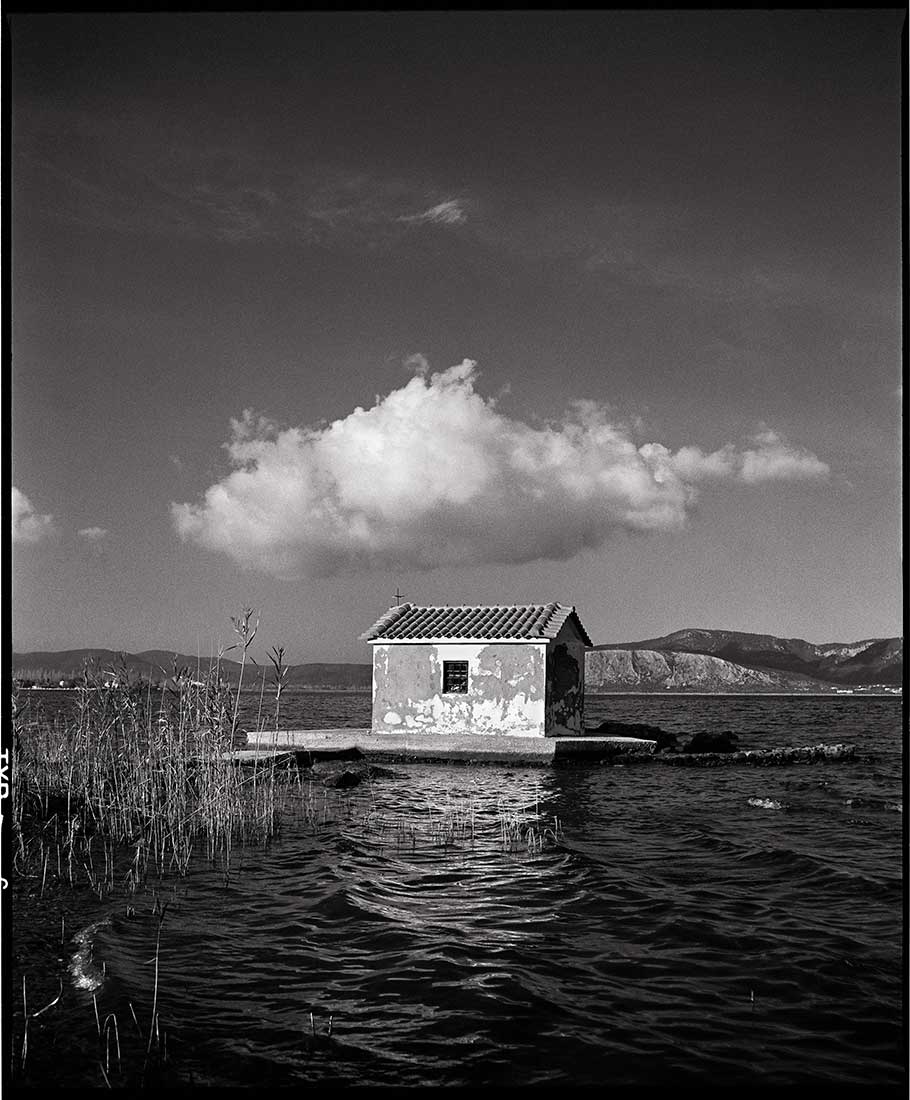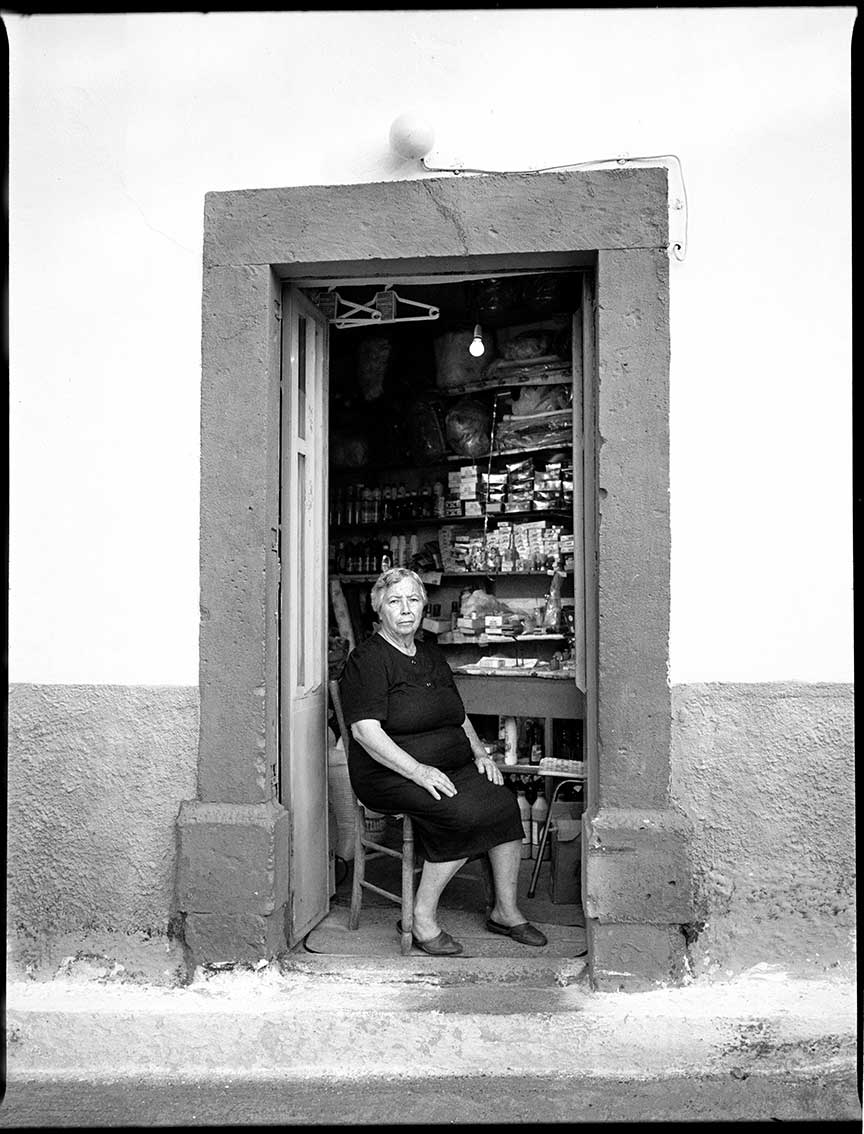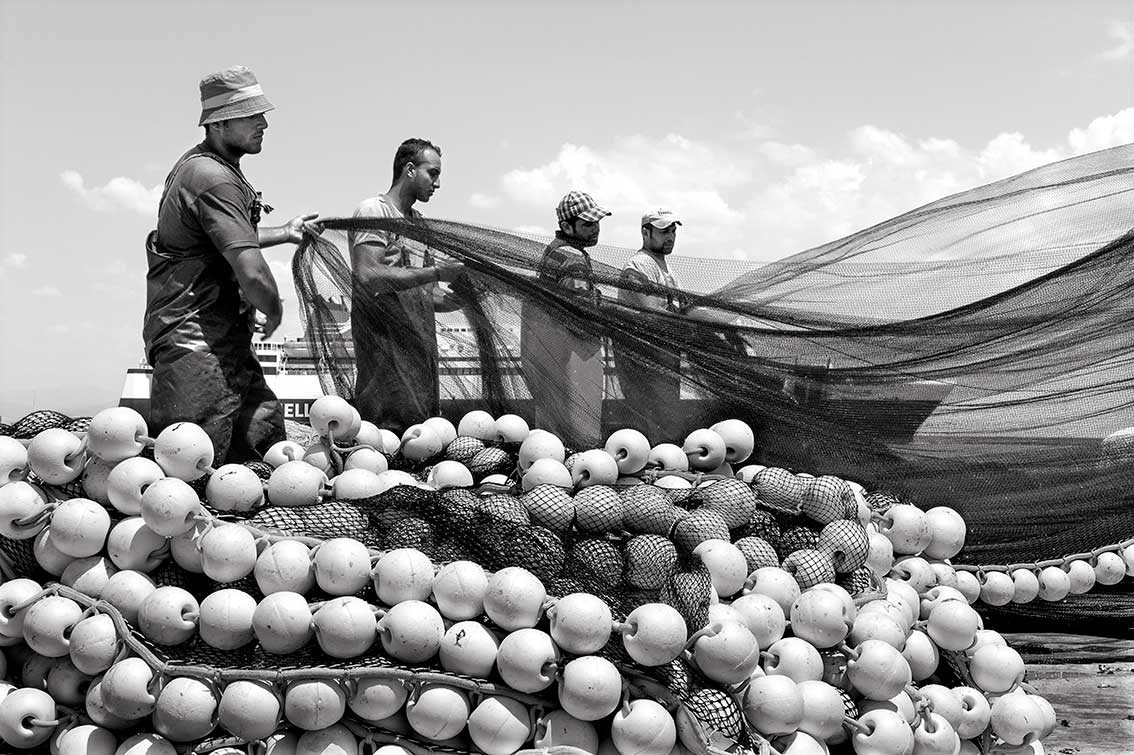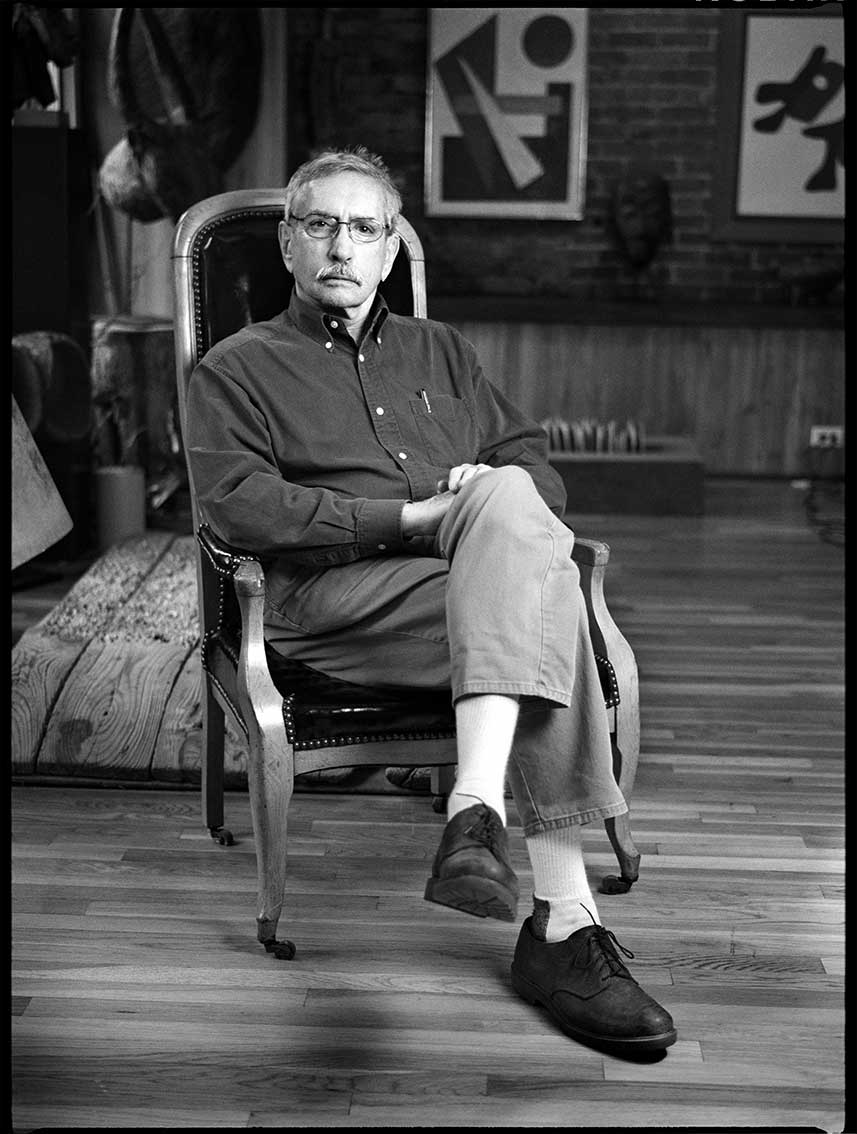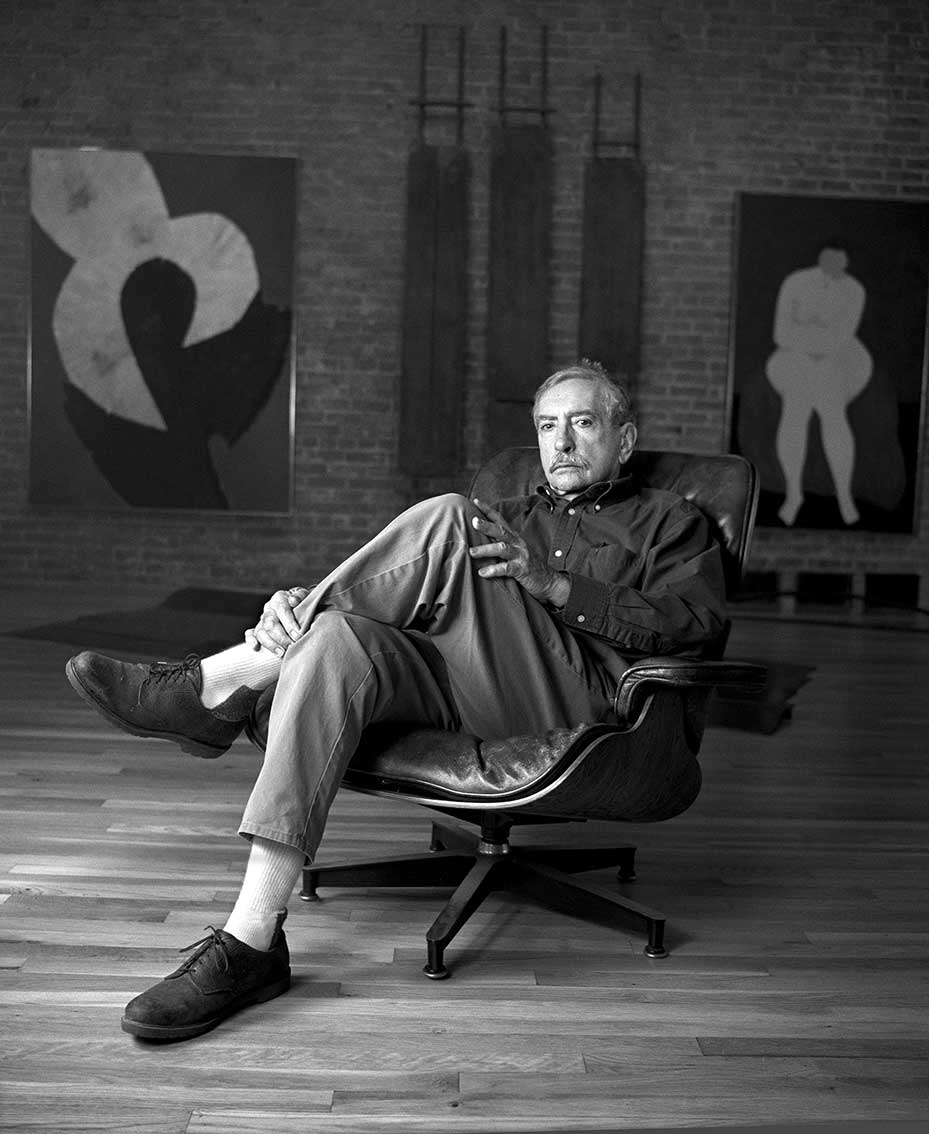DIMITRIS YEROS | Eλληνικά – Δημήτρης Γέρος
2Series | A Lesbos Diary | Portraits
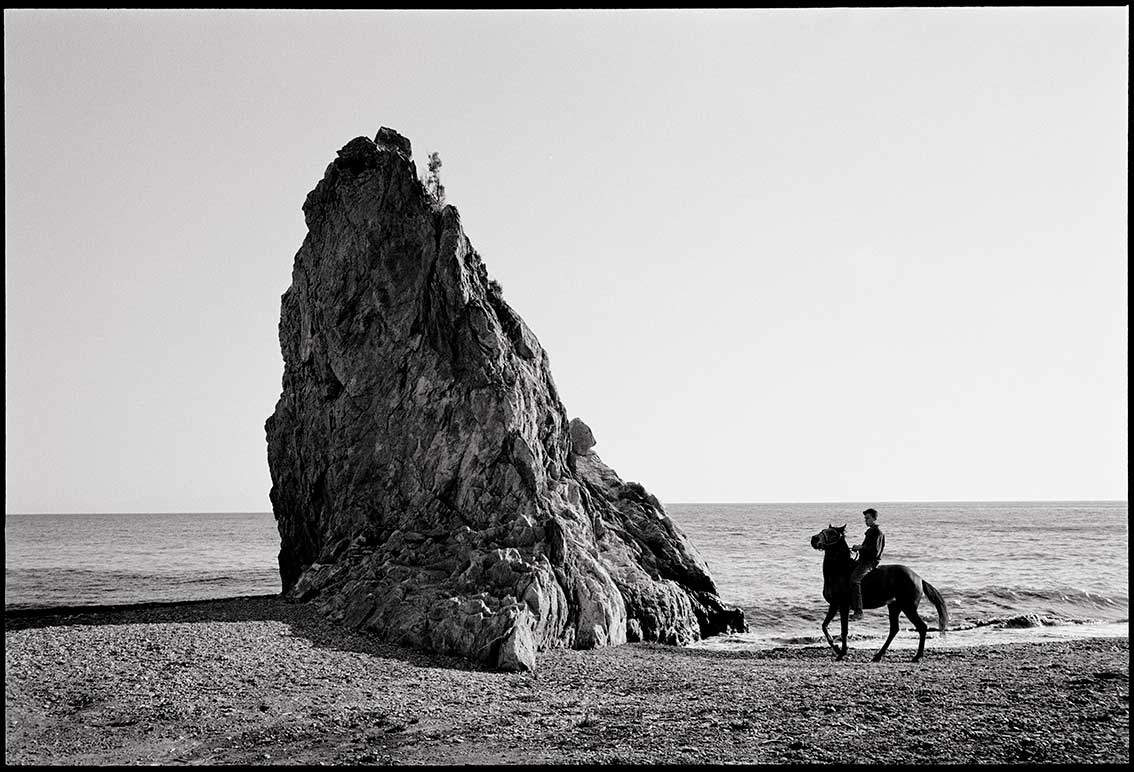
Dimitris Yeros © All rights reserved.

Dimitris Yeros (Eλληνικά – Δημήτρης Γέρος), was born in 1948, is a Greek artist-photographer considered to be one of the most influential Greek artists of his generation. Yeros was born in a small town under the shadow of two mythical Greek mountains: Mount Parnassus and Mount Helicon. Not far from there were the museum of Thebes and the museum of Chaeronea, with the majestic lion, where he mostly gained knowledge and was influenced by ancient Greek history, mythology, and art.
Yeros has exhibited in countless Solo exhibitions around the globe, and his work is part of public and private collections at some of the most prestigious museums around the world, including the Tate Britain, National Portrait Gallery-London, The British Museum-London, and Museum Bochum-Germany.
In addition, he is considered one of the pioneers of artistic movements in Greece, such as Body Art, Performances, and Video Art, and his beautiful surrealistic paintings are presented in galleries around the globe.
In this article, we are delighted to present two of his magnificent projects to spotlight his over 30 years of life achievements in photography.
DIMITRIS YEROS | Eλληνικά – Δημήτρης Γέρος
Dimitris Yeros has presented his works in 58 solo exhibitions in Greece and abroad, including Cologne, Dusseldorf, Kassel, Bochum – Germany (Bochum Museum), Strasbourg, Michigan (Kelsey Museum of Art), New York, Oxford (Oxford University), Darmstadt, Nicosia, Indiana -USA (National Gallery), Heidelberg, Barranquilla – Colombia (Museo de Arte Moderno) Berlin, Milan, Mexico, Wuppertal, Mannheim, Taipei-Taiwan, etc.
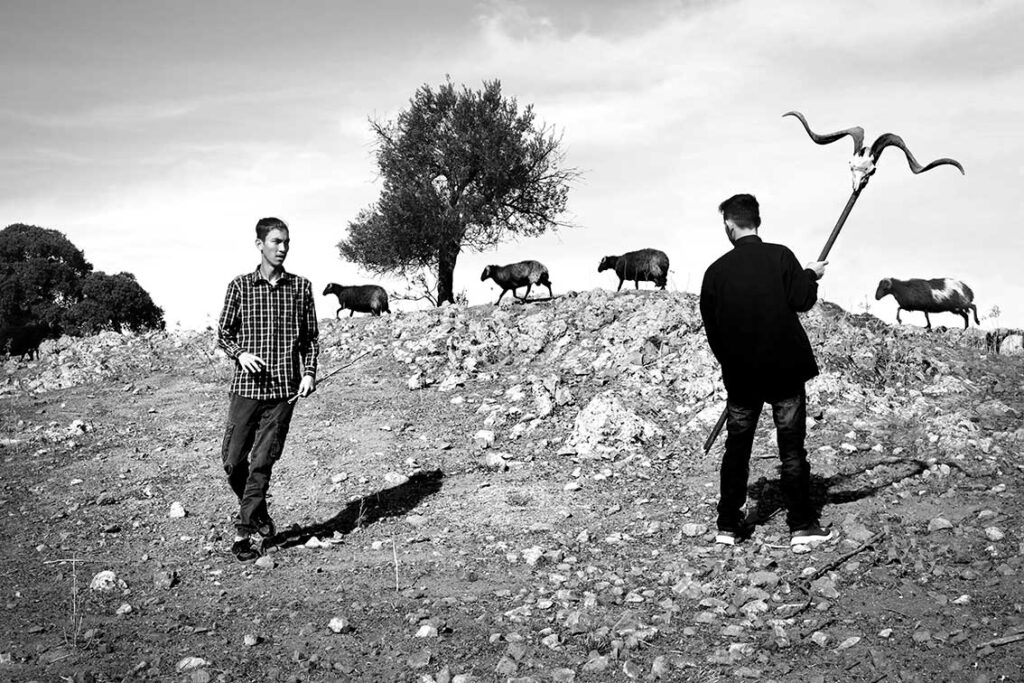
Dimitris Yeros © All rights reserved.
His poetry collection, The Sparkling Bathtub, was published by Kastaniotis in 1976. In addition, he has published the photo albums Theory of the Nude, text by Peter Weiermair (Planodion, 1998); Periorasis, with texts by Michel Deon and Pierre Devin (Phyllo, 1999); For a definition of the Nude, text by Peter Weiermair(Phyllo, 2000); Shades of Love, foreword by Edward Albee and introduction by John Wood (Insight Editions, San Francisco 2010 (listed in the ten best books of 2011 by the American Library Association); Photographing Gabriel Gárcia Márquez (Kerber Photo Art, 2015), Another Narcissus with texts by Edward Albee and John Wood, (Phyllo, 2016). The books on his work are: D. Yeros, text by Yannis Patilis (Forkys 1984); Dimitris Yeros, with texts by Peter Spielman, Heribert Becker, and Ι. Rosenthal-Kamarinea, (Bochum Museum, 1986, on the occasion of his retrospective); D. Yeros, text by Chrysanthos Christou (Synecheia 1997); D. Yeros, text by John Wood, (Municipality of Hermoupolis 2001); D. Yeros – S. Karavouzis, text by Athena Schina, Kydonieos Foundation, Andros 2008.
His works can be found in many private and public collections in Greece and abroad: Tate Britain, International Center of Photography-New York, Maison Européenne de La Photographie-Paris, National Portrait Gallery-London, The British Museum-London, Museum Bochum-Germany, Tama Art Museum- Tokyo-Japan, The Montreal Museum of Fine Arts-Canada, National Gallery of Greece, Museum of International Contemporary Graphic Art-Norway, Musee d’Art Contemporain of Chamalieres, Museo de Arte Moderno de Barranquilla-Colombia, New Hampshire Institute of Art- Boston, etc.
His collaborations include the Throckmorton Fine Arts of New York, the Holden Lunts Gallery of Palm Beach, and the Paul Goebel Fine Art of Mexico.
A Lesbos Diary
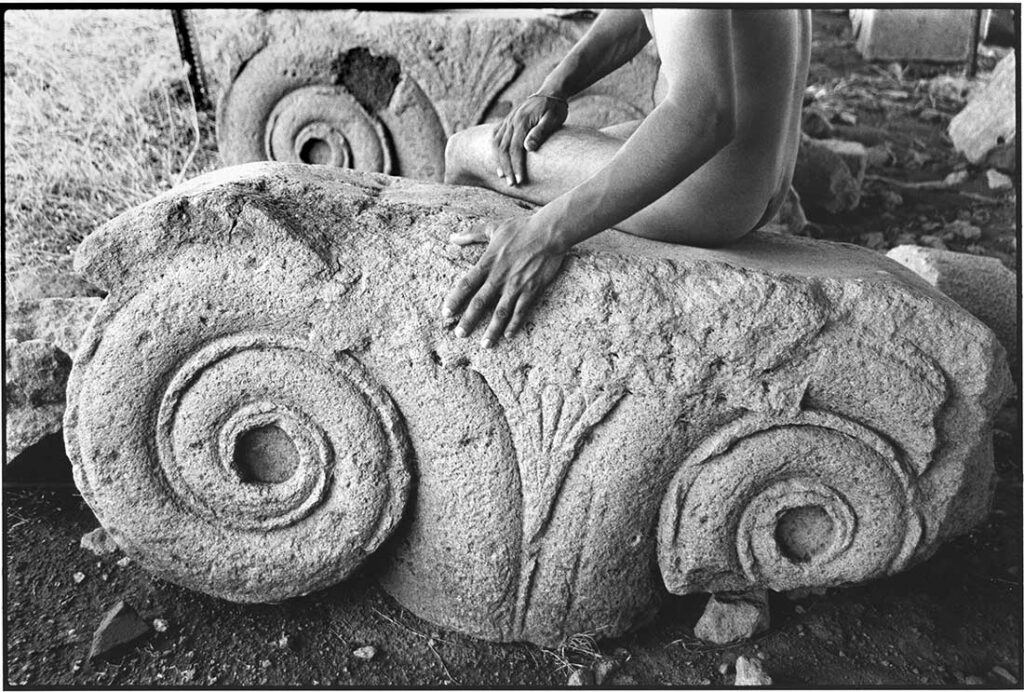
Dimitris Yeros © All rights reserved.
Lesbos, a Greek island embraced by the sea and decked out in a wide array of landscapes, also sports remnants of its long-ago and disparate histories. Dimitris Yeros has lived on Lesbos for a great part of the past thirty-five years, mostly during summers, the rest of the time in Athens and sometimes New York. He is attuned to both the multi-layered history of the island and to the idea that time seems to have slowed down a bit there: he says that life goes on on Lesbos much as it has for years because the villagers like it that way, and the island is not deluged with tourists as some other Greek islands are.
A photographer and painter, Yeros was one of the first Greek artists to introduce video art, mail art, body art, and performance art. He has had 58 exhibitions in a number of countries. Apparently, this has neither worn him out nor diminished his masterful ability to turn rocks and tattered reminders of the past, as well as male nudes, posing in difficult ways in unexpected places, into works of art. Armed with that little magic machine, a camera, and that expandable human capacity we call imagination, he comes up with surprises, conundrums, and charms.
He is clearly in love with the island, both its present and its past, which are so visibly interlinked. Its antediluvian past makes a rather startling appearance: a jagged, bristling, vertical rock that twists as it ascends over placid, shallow water. Its irascible surface suggests at first glance that it might be a botched missile that strayed from some dark planet, but, well, it’s more likely to be a random piece of rock torn loose by one of the fierce volcanoes that gave birth to the island or disturbed it postpartum during centuries long gone. At any rate, it serves a momentary purpose: a bird has found its pinnacle, an accommodating perch.
Yeros finds another tall and somewhat similar rock formation on a beach, this one a mammoth triangle that he endows with a certain elegance by adding a diminutive horse and rider, the spaces between the horse’s delicate legs playing with the shape of the rock. Unsurprisingly, Lesbos is plentifully supplied with rocks. On a massive set of lighter-colored rocks in a dark sea, a naked man stands tall as if to proclaim his dominance.
Yeros’s pictures of villages and villagers on Lesbos exhibit both sympathy and compositional clarity. A tiny church that has seen better days sits directly on the sea; a cloud hovers just above, cannily forming an extra protective roof. Elsewhere, a village climbs a hill above its reflection in a placid harbor, while on an adjacent hill, five geese perform a military drill, marching behind one another in perfect order.
The sea provides food and work: in one photograph, fishermen work on their nets, which unfurl in gracious counterbalancing curves; below them lies a jumble of bubble-shaped floats piled up in slightly curving lines. And suppose such indications of the surrounding sea’s importance were not sufficient. In that case, a cleverly balanced image states it almost abstractly and quite succinctly: a diagonal slice of a freighter’s hull occupies nearly half the picture, a mooring line crosses it on an opposing diagonal, and a horizontal pier in the near distance offers to meet that line just outside the frame.

Dimitris Yeros © All rights reserved.
One astonishing image suggests that the island’s verdant landscapes and rocky outcrops are not its entire story: this photograph centers on a long dead, Y-shaped tree in an endless, empty field of sand and a pervasive atmosphere of unidentifiable light — most likely from the sunset – that casts a dark shadow of the tree toward a low and apparently lightless moon in the distant sky.
In many reaches of Greece, history refuses to die quietly; instead, it bequeaths its lingering remains to anyone who notices it doggedly, keeping its place in the contemporary landscape. This is true on Lesbos as well, and Yeros notices. Many of his Lesbos photographs play a complex game with time. Photography, of course, has a widespread and unearned reputation for stopping time, something, not even a clever machine can do, for time does not stop. But Yeros and his camera pay their respects to several key moments in the island’s past and introduce them to a complex present.
The ancient Greeks left behind column bases and pieces of a column itself. Rome bequeathed to the future a mighty aqueduct as well as a powerful statue of a lion seated upright; its front legs have broken off and replaced by metal rods. But a little boy sits upon the lion’s pedestal, his little dangling legs a sly remark if not quite a replacement for the lion’s own. The medieval era entrusted to the future a stone bridge supported by a handsome arch. An ancient and frequently rebuilt fortress is attended by a flock of birds that has arranged itself to echo the outlines of the decrepit building and the land in front of it. The Turks left an old thermal bath (which today, Yeros writes with an exclamation mark, has been converted to a spa for the nouveaux riches), while “collapsing minarets” are most likely from a late nineteenth/early twentieth-century mosque.
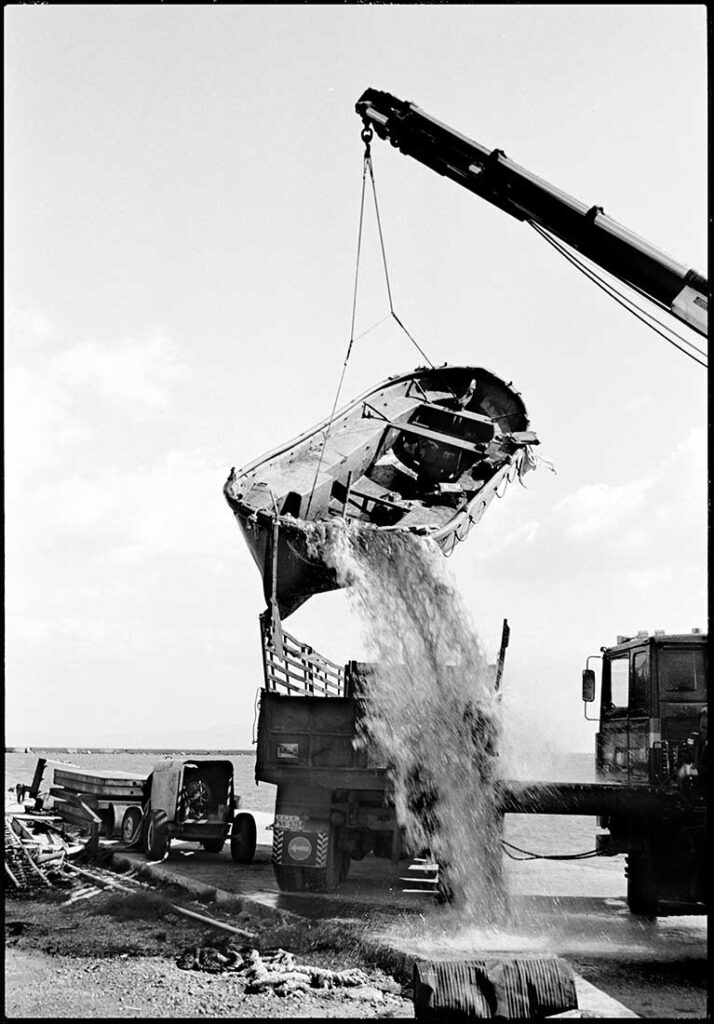
Dimitris Yeros © All rights reserved.
The past may lie in ruins, but it is always present.
On Lesbos, Yeros’s images of young nude men play a sub rosa game with time. Nude men have had a long history without reference to the Eden story. For at least two centuries in pre-classical and classical Greece, the youthful nude male was a prominent figure. Kouroi (singular: kouros), sculptures of a generic, naked male athlete, stood for the high level of Greek civilization (and a professor I had in graduate school thought they also signified the moment of the greatest beauty and physical potential of the human being. Modern medicine comes pretty close to agreeing with that physical estimate.) The word ‘gymnasium’ comes from the Greek for ‘naked,’ and athletes in Panhellenic competitions might be naked, and Olympic athletes, after a while, shed all their clothes. Yeros’s photographs obliquely refer to this long-ago tradition in his country, placing his contemporary models metaphorically in two-time frames at once.
Different times and cultures have regarded images of naked males differently. The nineteenth century thought them dangerous. The photographer Guglielmo Pluschow spent time in jail for corrupting minors. His cousin Wilhelm von Gloeden did better by arranging his pictures of young and largely undressed adolescents as classical groups and selling anything too explicit under the table. But women were to be protected at all costs: the painter Thomas Eakins was forced to resign from The Pennsylvania Academy of Fine Arts because he removed a male model’s loincloth in a coed class.
Near the end of that century, the physical fitness craze heralded a change of opinion, at least temporarily, though genitals stayed discreetly hidden. Opprobrium lingered. In the 1930s in America, George Hoyningen-Huene and George Platt Lynes, two fine photographers of the naked male, seldom saw those pictures presented in public; Lynes refused to exhibit his for fear they would ruin his career. For a long while after that, it was illegal to send images of naked men through the U.S. mail.
Repeated attention to naked males has an air of homoeroticism, which is slightly ironic in this context, considering that Lesbos got its name from the great and lesbian female poet Sappho, who lived on the island. (A few scholars believe she was married and had a daughter, but much of the poetry by Sappho that still exists consists of love songs for girls and women.) At any rate, it’s worth noting that many, perhaps most, women respond esthetically and otherwise to a beautiful male body. And why not?
Yeros says that none of the young men he photographs are professional models who work all too hard at looking professional. He looks upon his models as part of the landscape. Indeed there are images of men quietly declaring their importance, dominance, or unity with the landscape, like the one who stands tall on a massive rock formation in the sea, another partially visible from behind like an afterthought atop a rocky mountain, or two men who seem to belong in a cavern beside a plummeting waterfall.
There are also men celebrated not for any apparent communication with the land but for their ability to perform feats of muscle and daring that twist their bodies into complicated postures.
One such beautifully composed image, looking upward at an angle, finds the silhouette of a man climbing a geometric network of metal rods. Another admires a man who strains to twist an already twisted bicycle into unrecognizability.
Yeros initiated such images in 1989 with a photograph of himself standing in a complex pose at the distant end of the old bath, his shadow rendered crazed by his flash. More than two decades later, he snapped a frightening, daring feat: a young man, seen suspended against the sky, is jumping from one mountain down to another – presumably, hopefully – there being no evidence of a safe place to land.
Time apparently has relaxed the fear or whatever it was of masculine nudity, at least in some places. Yeros not only ratifies the subject by association with antiquity but ties it to time by tying it to the island’s history. One youth lies on his back on what remains of a series of Greek column bases. Another stands on the arch of a Roman aqueduct. Yet other crouches before a medieval bridge; in a second image, its arch frames a man, perhaps the same one, in the distance. Twice, male figures stand before minarets. More recent, but old enough to be decayed, is a ruined hotel where an elderly artist studies a young model, both of them nude. And a young gypsy fellow sits on the edge of a chair in an abandoned school that shows clear signs of neglect.
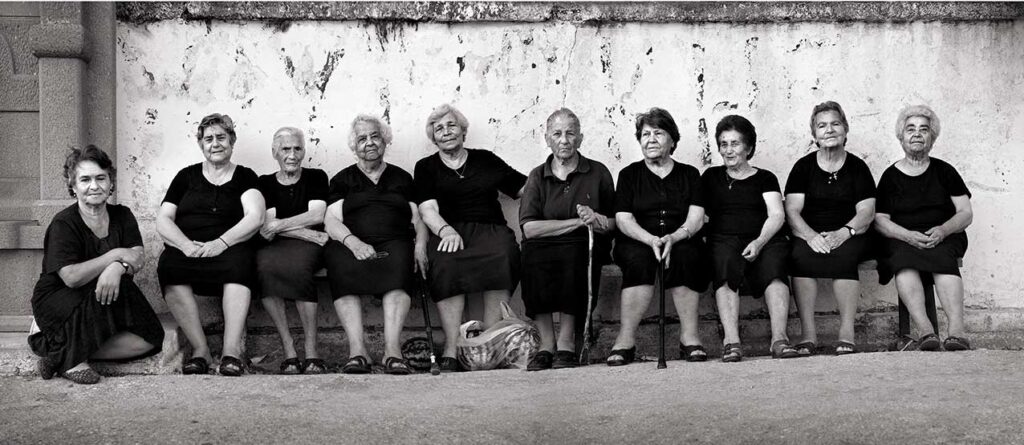
Dimitris Yeros © All rights reserved.
There are precedents for placing a nude of sorts before an ancient ruin: in the sixteenth century, an illustrated book on anatomy depicted a flayed figure before a ruin, doubtless a reminder that we, too, will decay one day. And Yeros’s young men in the prime of life before the crumbling remains of history seem to carry the same message, though the vibrant figures of the youths suggest that the short passage of individual humans in the face of time’s relentless advance can have its exuberant moments.
The moment a work of art leaves the artist’s hands, he or she loses control of its meaning, which passes to observers. An onlooker could look at these photographs that so tellingly present the compression of centuries and could interpret them in a way or ways that says as much about the viewer as about the images.
Some might think that, as Macbeth had it, “all our yesterdays have lighted fools/The way to dusty death,” and we today will follow fools, emperors and empires down the same dusty path, though few of us will leave behind evidence strong enough to stand upon. Or, looking at such fine bodies, such physical strength, others might decide the message is that every generation is a fresh start and may realize its own greatness.
The repetition of several men with their backs to the remaining evidence of earlier achievements might also bring to mind that, as Santayana’s warning had it, “Those who do not remember the past are condemned to repeat it.” Or possibly, such youthful figures accompanying the evidence of former greatness would remind us that “We are dwarfs standing on the shoulders of giants” –a statement so meaningful it has been attributed to several prominent people.
Images as rich as these may well tease the mind with possibilities while pleasing the eye at the same time. T.S. Eliot once received a query from a student who had a theory about one of Eliot’s poems and wanted to know if that was indeed what the poet had in mind. Eliot wrote back that it was not but that it seemed to him a quite reasonable and defensible explanation.
Yeros’s imagination, or inventiveness, also records nude bodies involved in pursuits intended mainly to delight the eye or puzzle the mind. There’s a fellow who holds up in each hand a wonderfully curving set of horns once worn by a kudu. Another young man standing before the sea holds up a fan-shaped branch composed of thin branches that seem to be swept by the wind into a delicate pattern. Yet another fellow, seen from shoulders to mid-thigh from the back, has crossed his arm behind his back. He holds a small bird in one hand; his arms cast dark shadows across his midriff, and the bird casts inexplicable shadows over his buttocks. Then there’s a man seen from behind with his arms stretched wide for no apparent reason as he seems to contemplate or address a donkey in the middle distance. As the donkey has one ear standing almost straight up as if it were a horn, the man might almost as well be addressing a unicorn. Yeros was so friendly with Gabriel Garcia Marquez that he published a book of his portraits of that author: perhaps a little bit of magic realism rubbed off on the photographer.
The photographs explore human and nature’s beauty and intricate approaches to time: villagers preferring to live as they have for a long while, contemporary enough without being up to date. Persistent evidence of bygone centuries, the differently flavored eras of Greek history. Young bodies at that time will not allow staying as beautiful as they are. All of this is seen with a keen eye, a knowledge of how convincing or beguiling a picture can be, and a camera that can set it all down in no time at all.
Portraits
Mahfouz is regarded as one of the first contemporary writers in Arabic literature, along with Taha Hussein, to explore themes of existentialism. He is the only Egyptian to win the Nobel Prize in Literature. He published 35 novels, over 350 short stories, 26 movie scripts, hundreds of op-ed columns for Egyptian newspapers, and seven plays over a 70-year career, from the 1930s until 2004.
All of his novels take place in Egypt, and he always mentions the lane, which equals the world. His most famous works include The Trilogy and Children of Gebelawi. Many of Mahfouz’s works have been made into Egyptian and foreign films; no Arab writer exceeds Mahfouz in the number of works that have been adapted for cinema and television. While Mahfouz’s literature is classified as realist literature, existential themes appear in it.
Dimitris Yeros © All rights reserved.
This ongoing project features portraits of well-known writers, artists, filmmakers, actresses, and composers, and, to name a few, like Edward Albee, Louise Bourgeois, Arman, Costa-Gavras, Dennis Oppenheim, Jeff Koons, Carlos Fuentes, Michael Cacoyannis, and Gabriel Garcia Marquez.
Dimitris Yeros © All rights reserved.
“With Garcia Marquez, there was, from the very first moment, a warm kind of friendship, which was unfortunately cut short by his illness. So I was unable to take more photographs of him. Photographing Marquez was a sheer pleasure. He thoroughly enjoyed himself, although, at the end of each session, he told me jokingly that he would be going straight to bed because of me.”
-Dimitris Yeros, Interview for Neo Magazine, 2016
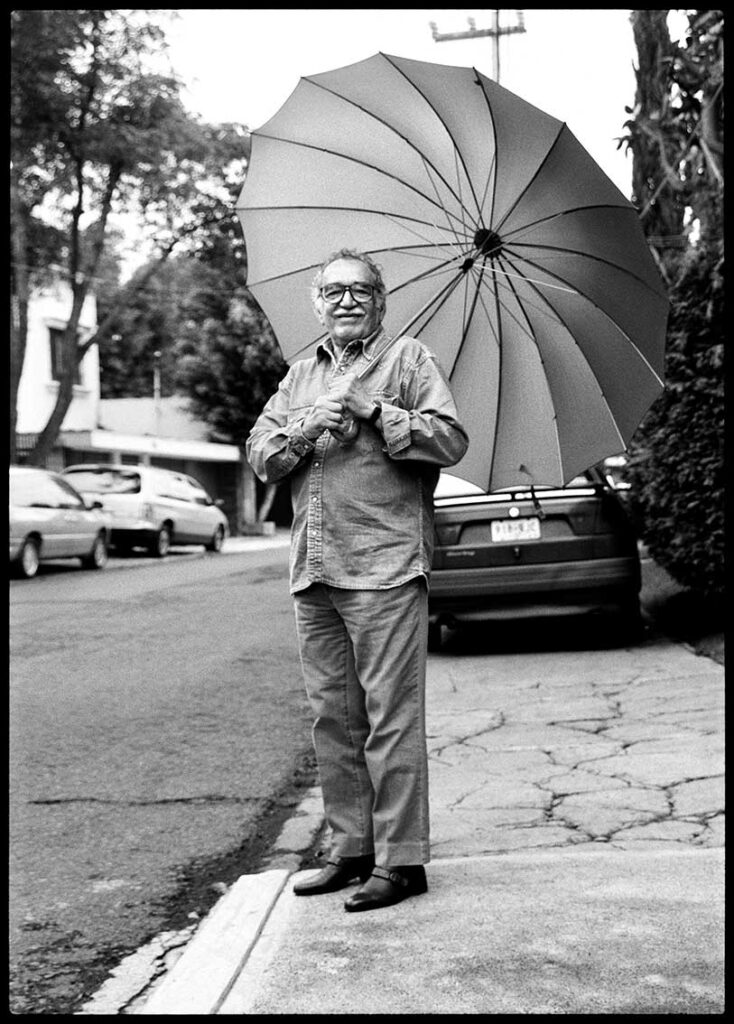
( Aracataca, March 6, 1927 – Mexico City, April 17, 2014 ) was a Colombian writer and journalist. Recognized primarily for his novels and short stories, nonfiction, speeches, reports, film reviews, and memoirs.
Dimitris Yeros © All rights reserved.
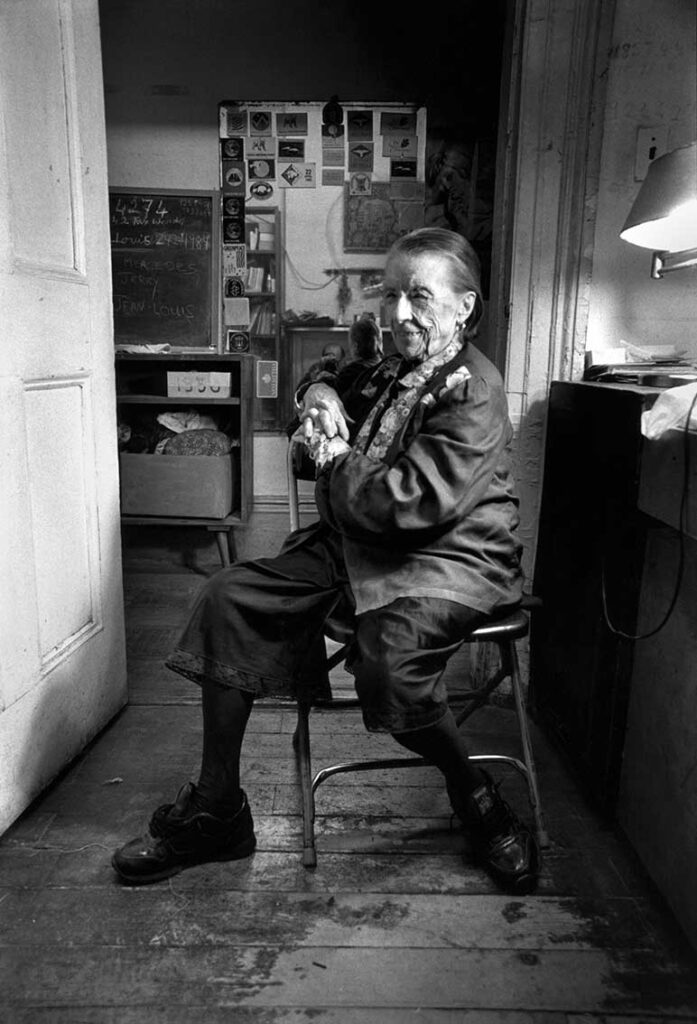
Dimitris Yeros © All rights reserved.
“I think I was special, creative, and a rather strange child who read a lot. I started at an early age to keep up with what was going on in the world of literature and the arts, not just in Greece but also in Europe.
Note that at that time America was not yet the center of the art world.
I was also very independent and somewhat rebellious. I had, perhaps even before I started elementary school, planned out my future, and the plan said I would work in the arts. After all, I knew I would never be able to work as a private employee or public servant.”
-Dimitris Yeros, Interview for Neo Magazine, 2016
His works are often considered frank examinations of the modern condition. His early works reflect a mastery and Americanization of the Theatre of the Absurd that found its peak in works by European playwrights such as Samuel Beckett, Eugène Ionesco, and Jean Genet.
His middle period comprised plays that explored the psychology of maturing, marriage, and sexual relationships. Younger American playwrights, such as Paula Vogel, credit Albee’s mix of theatricality and biting dialogue with helping to reinvent postwar American theatre in the early 1960s. Later in life, Albee continued to experiment in works such as The Goat, or Who Is Sylvia? (2002).
Dimitris Yeros © All rights reserved.

